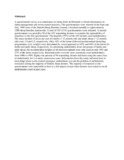| dc.contributor.author | Maingi, N | |
| dc.contributor.author | Bjørn, H | |
| dc.contributor.author | Thamsborg, SM | |
| dc.contributor.author | Dangolla, A | |
| dc.contributor.author | Kyvsgaard, NC | |
| dc.date.accessioned | 2013-05-04T08:43:17Z | |
| dc.date.available | 2013-05-04T08:43:17Z | |
| dc.date.issued | 1996 | |
| dc.identifier.citation | Vet Parasitol. 1996 Nov 1;66(1-2):39-52 | en |
| dc.identifier.uri | http://hinari-gw.who.int/whalecomwww.ncbi.nlm.nih.gov/whalecom0/pubmed/?term=Worm+control+practices+on+sheep+farms+in+Denmark+and+implications+for+the+development+of+anthelmintic+resistance | |
| dc.identifier.uri | http://erepository.uonbi.ac.ke:8080/xmlui/handle/123456789/18925 | |
| dc.description.abstract | A questionnaire survey was undertaken on sheep farms in Denmark to obtain information on sheep management and worm control practices. The questionnaires were inserted in the June and July, 1993 issue of the Danish Sheep Breeders Journal, circulated monthly to approximately 1200 sheep breeders nationwide. A total of 183 (11%) questionnaires were returned. A second questionnaire was posted to 50 of the 183 responding farmers to examine the repeatability of responses to the first questionnaire. The majority (97%) of the 183 farmers used anthelmintics. The mean number of doses per year for lambs (< 12 months old) and adult sheep (> 12 months old) were 1.9 and 2.3, respectively. Only 42% of the farms followed predetermined drenching programmes. Live weights were determined by visual appraisal on 45% and 84% of the farms for lambs and adult sheep, respectively. In calculating anthelmintic doses for groups of lambs and adult sheep, the recommended weights of the heaviest animals were only used on only 18% and 27% of the farms respectively. Benzimidazoles were the most commonly used anthelmintics from 1986 to 1993. Eighty one percent of 94 responding farmers had been using the same class of anthelmintic for 3 or more consecutive years. Information from this study indicated lack of knowledge about worm control strategies, anthelmintic use and the problem of anthelmintic resistance among the majority of Danish sheep farmers. The majority of responses to the questionnaire were repeatable at least to a fair degree except when farmers were asked to recall anthelmintics used in past years | en |
| dc.language.iso | en | en |
| dc.title | Worm control practices on sheep farms in Denmark and implications for the development of anthelmintic resistance | en |
| dc.type | Article | en |
| local.publisher | Danish Centre for Experimental Parásitology, Royal Veterinary and Agricultural University, Frederiksberg, Denmark | en |

